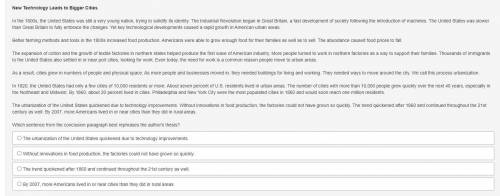
New Technology Leads to Bigger Cities
In the 1800s, the United States was still a very young nation, trying to solidify its identity. The Industrial Revolution began in Great Britain, a fast development of society following the introduction of machines. The United States was slower than Great Britain to fully embrace the changes. Yet key technological developments caused a rapid growth in American urban areas.
Better farming methods and tools in the 1800s increased food production. Americans were able to grow enough food for their families as well as to sell. The abundance caused food prices to fall.
The expansion of cotton and the growth of textile factories in northern states helped produce the first wave of American industry. More people turned to work in northern factories as a way to support their families. Thousands of immigrants to the United States also settled in or near port cities, looking for work. Even today, the need for work is a common reason people move to urban areas.
As a result, cities grew in numbers of people and physical space. As more people and businesses moved in, they needed buildings for living and working. They needed ways to move around the city. We call this process urbanization.
In 1820, the United States had only a few cities of 10,000 residents or more. About seven percent of U. S. residents lived in urban areas. The number of cities with more than 10,000 people grew quickly over the next 40 years, especially in the Northeast and Midwest. By 1860, about 20 percent lived in cities. Philadelphia and New York City were the most populated cities in 1860 and would soon reach one million residents.
The urbanization of the United States quickened due to technology improvements. Without innovations in food production, the factories could not have grown so quickly. The trend quickened after 1860 and continued throughout the 21st century as well. By 2007, more Americans lived in or near cities than they did in rural areas.
Which sentence from the conclusion paragraph best rephrases the author's thesis?
The urbanization of the United States quickened due to technology improvements.
Without innovations in food production, the factories could not have grown so quickly.
The trend quickened after 1860 and continued throughout the 21st century as well
.
By 2007, more Americans lived in or near cities than they did in rural areas.


Answers: 1


Another question on English

English, 22.06.2019 01:00
Will give if correct read the passage first of all, if someone says your dream is impossible, they’re wrong. you can’t prove that something is impossible-all you know is that [it] hasn’t been done yet. people said no one could scale mount everest, but in 1953, sir edmund hilary and tenzing norgay gazed down upon the world from its summit. people said that man could not fly, but in 1903, orville and wilbur wright made the first sustained powered flight in a heavier-than-air machine. people said, “okay, we admit that someone could climb mount everest, and we admit that man has learned to fly, but no one will ever, ever walk on the face of the moon.” if we can send three men a quarter of a million miles away and bring them home safely, is there any great task we cannot accomplish? which identifies the textual evidence that best supports the claim: the authors purpose is to persuade? a: the author shares historical information about the wright brothers. b: the author states that men have walked the moon. c: the author states that others who think your dreams are impossible are wrong. d: the author wants to know what tasks we cannot accomplish.
Answers: 2

English, 22.06.2019 02:30
Which component of a rhetorical argument is missing from the chart above? a. civics (civos) b. ethics (ethos) c. patriotics (patros) d. histrionics (histros)
Answers: 3

English, 22.06.2019 02:30
Based on her speech in the excerpt ,what can we infer about francesca
Answers: 1

English, 22.06.2019 09:00
In a debate focused specifically on the topic of whether new laws are needed to prevent distracted driving, the following argument is made. which type of special appeal does it demonstrate? “my opponent is correct—distracted driving is very dangerous. many activities—texting, talking on the phone, looking at maps, eating breakfast—all of these contribute to accidents. yes, we have statistics to support that. however, my opponent is totally ignoring the role that improper and inconsistent maintenance of your vehicle can also have in causing accidents! ” a. false analogy b. red herring c. bandwagon d. fallacy of argument from ignorance
Answers: 2
You know the right answer?
New Technology Leads to Bigger Cities
In the 1800s, the United States was still a very young natio...
Questions

Mathematics, 03.08.2020 14:01

Mathematics, 03.08.2020 14:01



Biology, 03.08.2020 14:01

Mathematics, 03.08.2020 14:01


Mathematics, 03.08.2020 14:01

Mathematics, 03.08.2020 14:01



Chemistry, 03.08.2020 14:01


History, 03.08.2020 14:01


Mathematics, 03.08.2020 14:01


Mathematics, 03.08.2020 14:01

Mathematics, 03.08.2020 14:01



